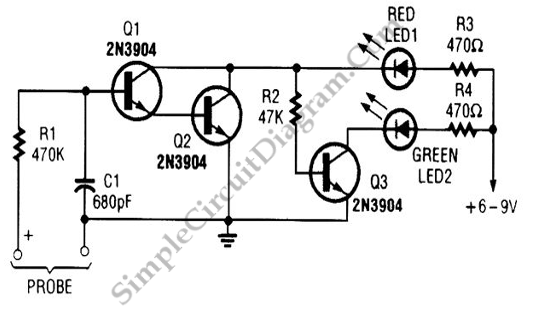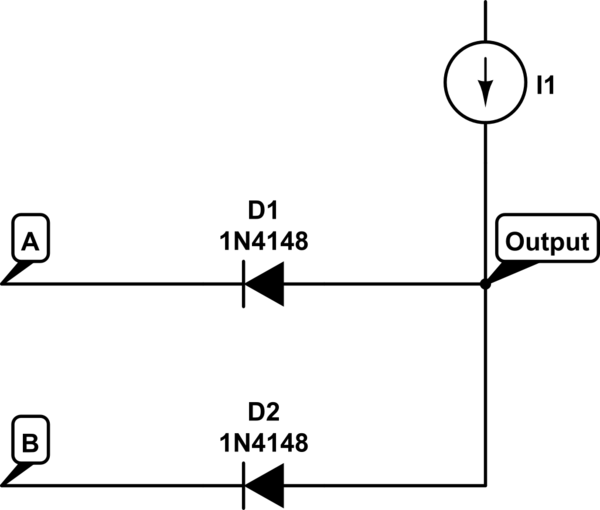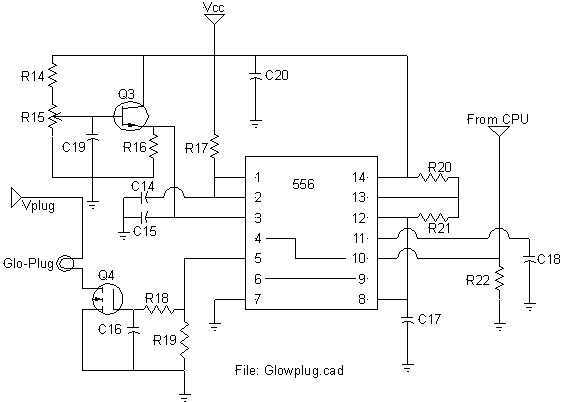
Logic probe

Transistors Q1 and Q2 create a buffer that offers the probe a suitable input impedance. Q3 and Q4 constitute a level detection circuit. When the voltage across the base-emitter junction of Q3 exceeds 0.6 V, the transistor activates, which in turn powers Q4 and illuminates the red (high) LED. Q5 and Q6 serve a similar purpose for the green (low) LED. Transistors Q1, Q4, and Q5 are PNP general-purpose silicon transistors (such as BC178), while Q2, Q3, and Q6 are also PNP general-purpose silicon transistors (like BC108). The low threshold is set at 0 V, while the high threshold is established at 2 V.
The circuit employs a configuration of PNP transistors to create a buffer and a level detection mechanism. The buffer formed by Q1 and Q2 ensures that the input impedance remains high, which is essential for accurate signal probing without loading the circuit. This is particularly important in sensitive applications where the probe must not influence the circuit under test.
The level detection functionality is achieved through the combination of Q3 and Q4. When the input voltage at the base of Q3 exceeds the threshold of 0.6 V, Q3 transitions from the cutoff region to the active region, allowing current to flow from the collector to the emitter. This action activates Q4, which is also a PNP transistor, resulting in the illumination of the red LED, indicating a high voltage condition.
Similarly, Q5 and Q6 are configured to detect lower voltage levels. When the input voltage drops to 0 V, Q5 activates, turning on Q6 and illuminating the green LED, signaling a low voltage condition. This dual-LED indication system provides clear visual feedback regarding the voltage levels present at the probe.
The selection of general-purpose silicon transistors such as BC178 for Q1, Q4, and Q5, and BC108 for Q2, Q3, and Q6, ensures that the circuit can handle the necessary current and voltage levels while maintaining reliability and performance. The defined voltage thresholds of 0 V for low and 2 V for high are critical for the proper functioning of the level detection circuit, allowing it to effectively differentiate between high and low states.Transistors Q1 and Q2 form a buffer, providing the probe with a reasonable input impedance. Q3 and Q4 form a level detecting circuit. As the voltage across the base-emitter junction of the Q3 rises above 0,6 V the transistor turns on thus turning on Q4 and lighting the red (high) LED. Q5 and Q6 perform the same function but for the green (low) LED. Ql, Q4, Q5 are all PNP general purpose silicon transistors (BC178 etc) Q2, Q3, Q6 are all PNP general purpose silicon transistors (BC 108 etc) The threshold low is 0 V, and the threshold high is 2 V.
The circuit employs a configuration of PNP transistors to create a buffer and a level detection mechanism. The buffer formed by Q1 and Q2 ensures that the input impedance remains high, which is essential for accurate signal probing without loading the circuit. This is particularly important in sensitive applications where the probe must not influence the circuit under test.
The level detection functionality is achieved through the combination of Q3 and Q4. When the input voltage at the base of Q3 exceeds the threshold of 0.6 V, Q3 transitions from the cutoff region to the active region, allowing current to flow from the collector to the emitter. This action activates Q4, which is also a PNP transistor, resulting in the illumination of the red LED, indicating a high voltage condition.
Similarly, Q5 and Q6 are configured to detect lower voltage levels. When the input voltage drops to 0 V, Q5 activates, turning on Q6 and illuminating the green LED, signaling a low voltage condition. This dual-LED indication system provides clear visual feedback regarding the voltage levels present at the probe.
The selection of general-purpose silicon transistors such as BC178 for Q1, Q4, and Q5, and BC108 for Q2, Q3, and Q6, ensures that the circuit can handle the necessary current and voltage levels while maintaining reliability and performance. The defined voltage thresholds of 0 V for low and 2 V for high are critical for the proper functioning of the level detection circuit, allowing it to effectively differentiate between high and low states.Transistors Q1 and Q2 form a buffer, providing the probe with a reasonable input impedance. Q3 and Q4 form a level detecting circuit. As the voltage across the base-emitter junction of the Q3 rises above 0,6 V the transistor turns on thus turning on Q4 and lighting the red (high) LED. Q5 and Q6 perform the same function but for the green (low) LED. Ql, Q4, Q5 are all PNP general purpose silicon transistors (BC178 etc) Q2, Q3, Q6 are all PNP general purpose silicon transistors (BC 108 etc) The threshold low is 0 V, and the threshold high is 2 V.





